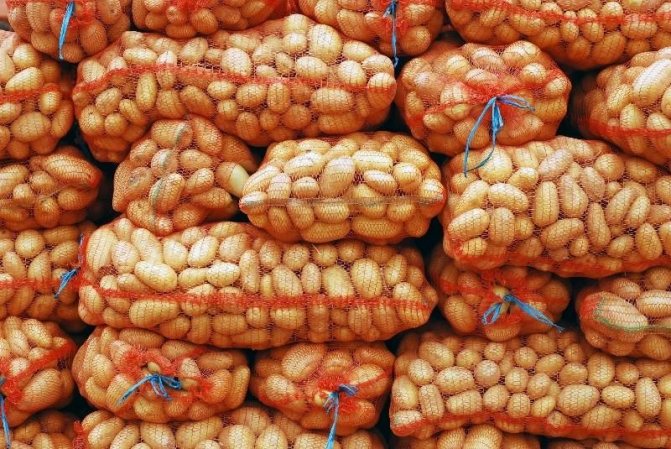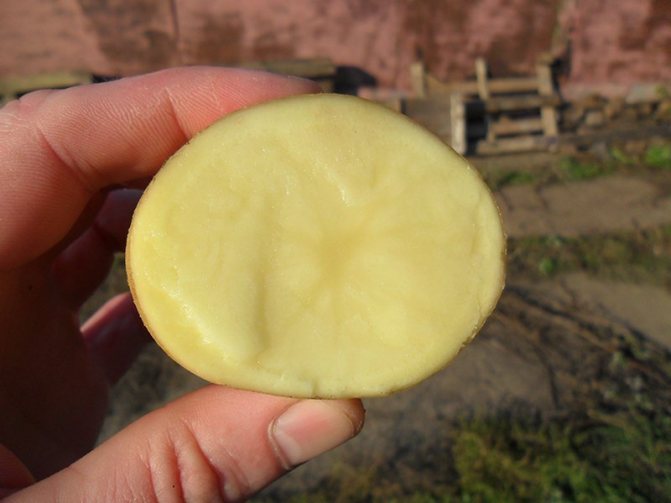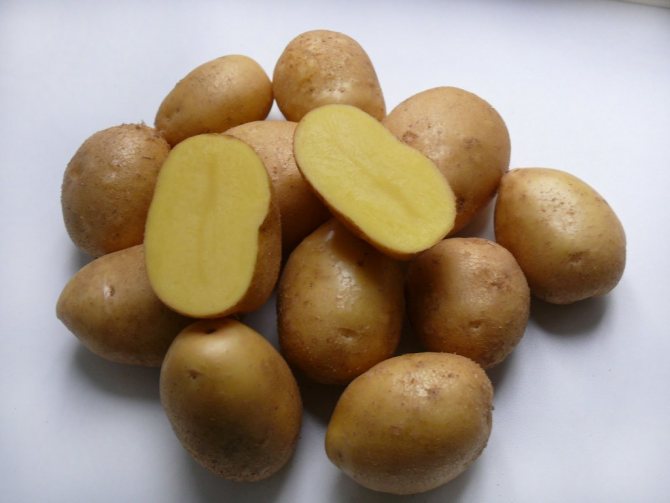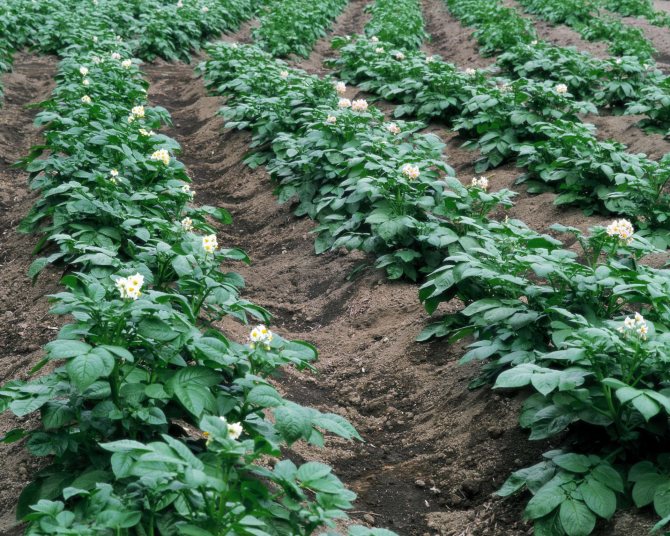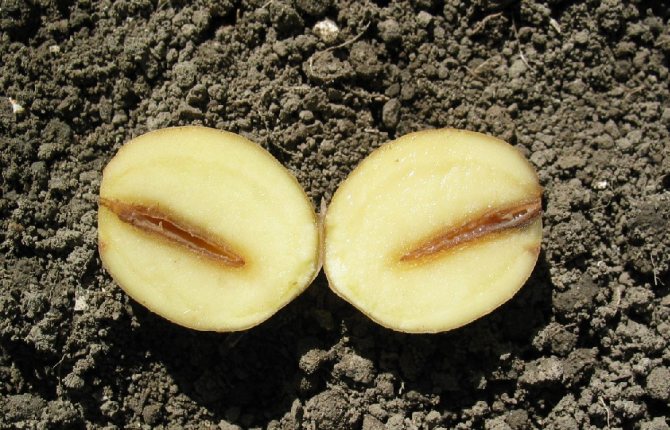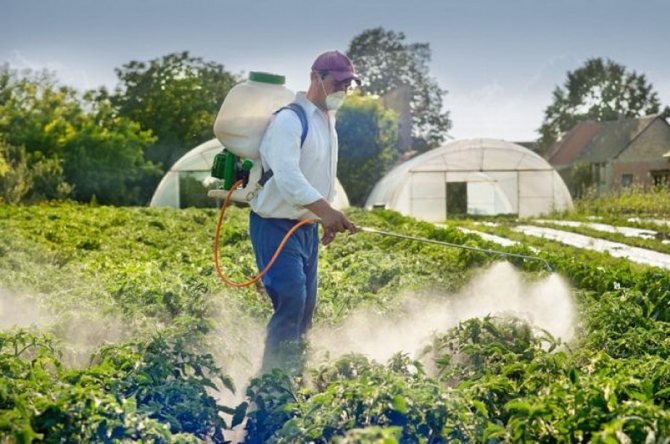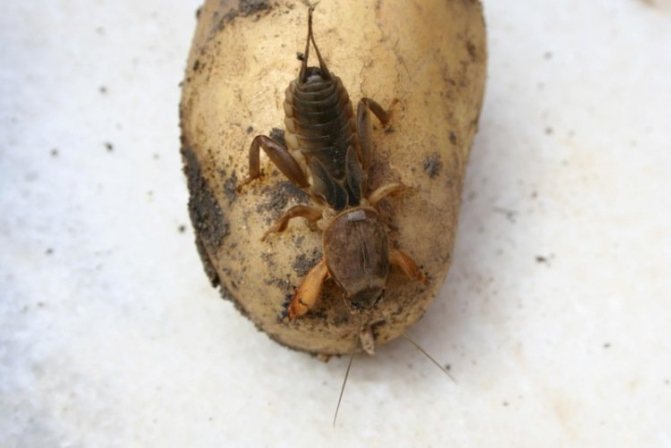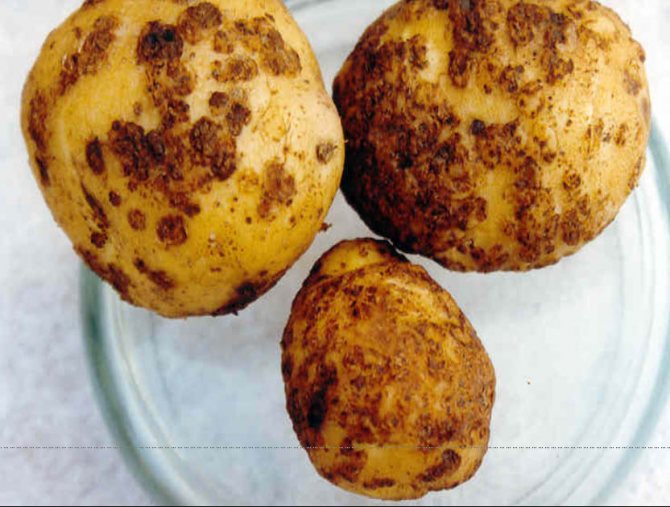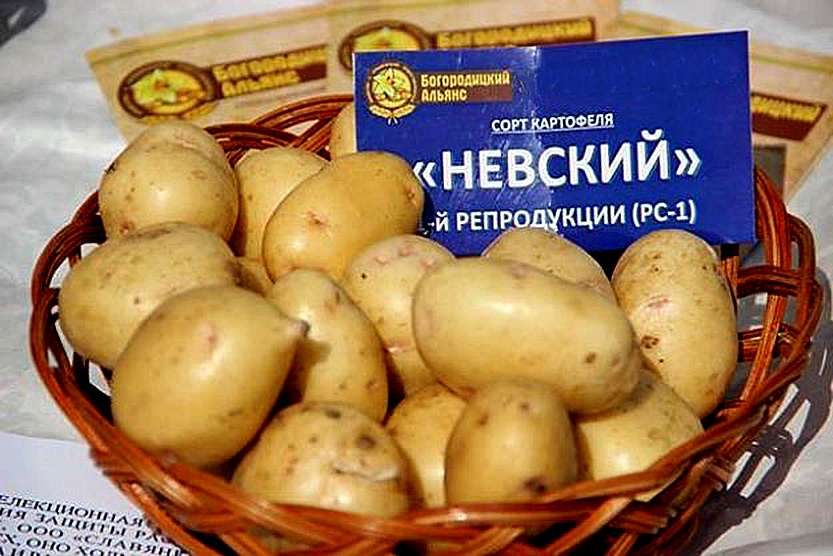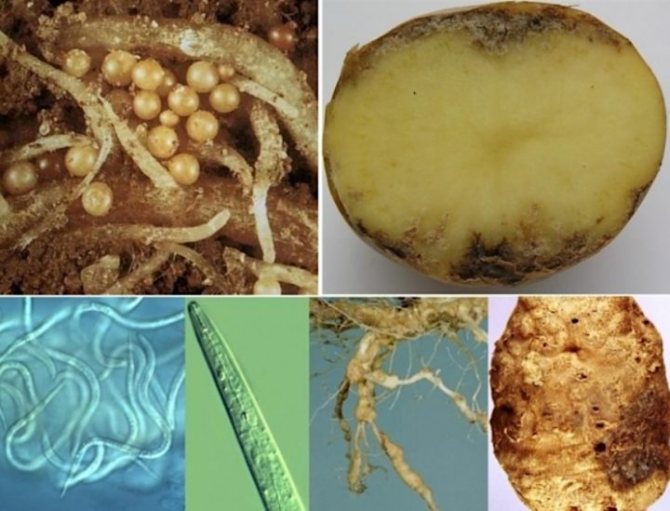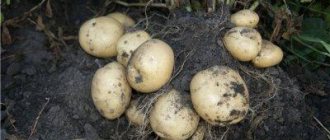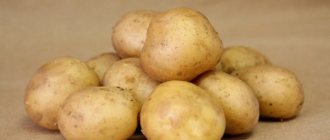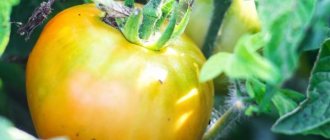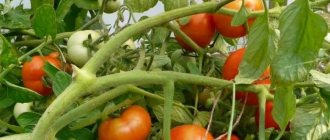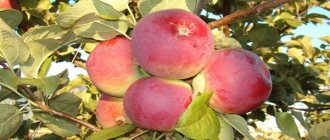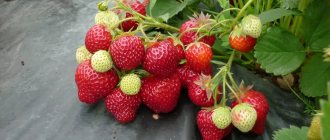Potatoes Nevsky: variety description
This variety was bred in the North-West Research Institute of Agriculture by crossing two other varieties (Veselovskaya and Candidate) back in 1976. It was included in the State Register of Varieties of the Russian Federation in 1982. It belongs to medium-late varieties of potatoes, the full maturity of the plant occurs in 75 - 90 days after the first shoots. The undoubted advantages of Nevsky include its yield, on average, about 35-50 tons of potatoes are obtained from one hectare of crops.
You will find information about the yield of other varieties in this table:
One bush of this variety forms 10-15 tubers. The tubers themselves are quite massive, they can reach up to 130 g each. They are oval-round in shape with a thin light yellow rind and creamy flesh that does not darken for a long time after cutting. Starch content 10 - 13%.
The eyes on the tubers are small, pinkish. Potatoes of this variety, among other things, have a long keeping period, however, in low temperature conditions, the tubers germinate faster than usual. Marketability remains at an impressive 92 - 95% mark.
You can find the keeping quality indicators of other potato varieties in the table below:
Bushes of Nevsky potatoes are low, erect, have many branched stems. During flowering, the plant has many white flowers, but they also fall off quickly. The sheets are wide, with a glossy surface, dark green in color. Due to their large size and surface, they reflect the sun's rays well, preventing moisture from quickly evaporating, which helps the bush to survive dry weather.
We bring to your attention some interesting materials about the properties of potatoes. Why is solanine dangerous, is it possible to eat potatoes raw and how is juice useful, why do people eat sprouts?
The photo shows the potato variety "Nevsky":
Variety history
The potato variety Nevsky was created at the Research Institute of Agriculture of the North-Western Regions in 1976. It was the result of the selection of two other varieties: Candidate and Veselovsky. Nevsky has collected the best properties and gained unprecedented popularity in collective farms, and later - among private farms. In 1982 it was entered in the state register of varieties.
Until now, the Nevsky variety is recognized as the best among those bred in Russia by the breeding method.
Growing features
For good growth, Nevsky does not require any unnecessary care or specific conditions. The only thing he needs is warmth. Therefore, it is better to plant it on the beds at that time of spring, when the last frosts have already passed.
From the fact that it is intended for cultivation in all regions of the Russian Federation, we can conclude that it is perfect for all types of our soils. However, sandy loam and light loams are more suitable for him than others. Illumination is another key to a bountiful harvest. You should not plant your potatoes in the shade of houses, trees, etc., because this will negatively affect its growth.
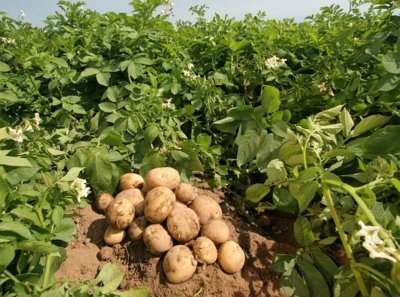
As for planting, immediately before planting the tubers, they should be thoroughly rinsed with a solution of potassium permanganate, this will disinfect your planting material.
Holes for tubers should be at a distance of half a meter from each other, the distance between the rows increases by several tens of centimeters, and the depth of the holes themselves should be at around 20 cm.Such a strict distance between plants is first of all maintained so that later it would be more convenient to do hilling.
About whether it is necessary to sprinkle potatoes, how it is better to do it - manually or using a walk-behind tractor, and whether it is possible to get a good harvest without weeding and hilling, read the articles on our website.
It is also recommended to place fertilizer in the form of bird droppings or manure in each well. Subsequently, this variety does not need any additional fertilizing with minerals. Read more about how to feed potatoes, when and how to apply fertilizers and which of them are the best, how to properly feed the plants when planting.
In general, these potatoes are grown using standard agricultural practices. If necessary, mulching can be used to control weeds and additional watering during dry times.
Testimonials
- Sergey Stepanovich. Taganrog. I have been growing potatoes of the Nevsky variety for many years. I love this variety for its ease of care and excellent immunity to various diseases. The exception is the nematode, but it has also learned to cope with it. I plant marigolds next to the potato beds, and it is beautiful, and pests are scared away. I dig in young potatoes in July, but I harvest the main crop in August. Throughout autumn, winter and spring, we use only our own potatoes. Therefore, I can say with confidence that the Nevsky variety is perfectly stored until the end of spring.
- Evgeny Viktorovich. Ryazan. Nevsky got acquainted with potatoes for the first time 5 years ago. A neighbor at the dacha treated me to his potatoes, which I really liked. He also provided planting material at the end of the season. For all 5 years, I have not encountered a major problem growing these potatoes. The Colorado potato beetle is not terrible for this variety, the leaves and tops are quickly restored, every year I carry out the prevention of late blight and nematodes. The variety is very productive, the potatoes ripen large, the tubers are even and beautiful. I collect almost 2 kilograms of vegetables from each bush.
Previous
Potato potato variety blue: characteristics and recommendations for growing
Diseases and pests
Nevsky potatoes boast good resistance to many diseases: Alternaria, Rhizoctonia, scab, late blight, potato cancer, fusarium, verticillium, late blight of tubers.
Its only weakness is the nematode. If this attack is not detected in time (and it is difficult to do this, because the plants susceptible to these pests outwardly do not differ in any way from healthy ones), then it, without exaggeration, can destroy almost all of your crop.
Nematodes are small worms that mainly affect plant roots. It is because of this that it is difficult to detect the coming trouble in time. And if you cannot notice the pest in time, then the best means of dealing with it will be preventive methods of protection:
- only healthy and undamaged tubers should be allowed for planting;
- alternation of crops and the return of potatoes to their former planting site no earlier than 3 years later;
- constant removal of weeds and digging of the soil in the fall;
- if plants affected by a nematode were found, then they should be immediately separated from healthy ones and subsequently burned.
You can hear and see about possible biological methods of protection against nematodes in this video:
Often, gardeners are also troubled by such pests as Colorado beetles, potato moths, bears, wireworms. On our site you will find a lot of useful recommendations on how to deal with them effectively:
We recommend to read: Design and purpose of KS truck cranes. Review of models KS-2563, 2571, 4456, 65715, 4372, 6471, 6362, 8161, 3561, 6473, 55744, 5473 and other self-propelled cranes of domestic production. Advantages and disadvantages of different handling equipment chassis.Features of equipment repair
Excellent yield, culinary and taste characteristics, unpretentious cultivation. All these features have made Nevsky one of the most popular varieties of potatoes both in our homeland and abroad. So you can be sure that it will not become superfluous on your site.
At the end of the article, I would like to say that there are many varieties and ways of growing them. We invite you to get acquainted with modern Dutch technologies, learn all the intricacies of growing early varieties, read about which varieties are popular in Russia and what are grown in other countries of the world, how to turn potato growing into a profitable business. And also everything about alternative methods: under straw, in bags, in boxes, in barrels, from seeds.
Read also: Prestige drug: instructions for the use and processing of potatoes from the Colorado potato beetle, what harm to health
We also offer you to familiarize yourself with other varieties of potatoes that have different ripening periods:
Disease resistance
From east to west, planted "Nevskaya" potato, the description of its resistance suggests that the variety is immune to pathotype I cancer and rhizoctonia disease.
The variety has moderate susceptibility to late blight, both in terms of tops and tubers. In this regard, a careful examination of the bushes at a time when the drops in night and day temperatures create morning ross on the leaves is a must.
The starting dry spot on potatoes will serve as a signal for treatment with fungicidal preparations. By applying special means on time, the potatoes will not even notice that the fungus already had intentions to multiply.
But the potato of this variety has an increased susceptibility to the golden nematode (R01). Therefore, if you suspect that your garden is infected with cysts, and they can remain viable for up to 15 years, this variety should be discarded.
Crop rotations, carried out correctly, will bring their positive to the cultivation of the variety. The use of green manures, such as winter mustard, radish, lupine, will heal the soil after the first season of use.
Applying an optimal amount of organic fertilizers to the soil will significantly reduce the number of viable potato nematode larvae.
To prevent the introduction of the pathogen into the garden, it is necessary to carefully consider the choice of planting material.
If you really like the variety, and the nematode bothers, then experienced vegetable growers go to the trick and change the potato varieties in places, while carefully recording where and which variety was planted in which year.
Description of the potato variety Nevsky
This variety has a unique ability to survive in different climatic conditions, it easily tolerates rainy periods and high temperatures. Now the variety Nevsky has been sown for 26% of the territories intended for potatoes in the Russian Federation, since it is guaranteed to provide the country with a crop in almost any weather conditions.
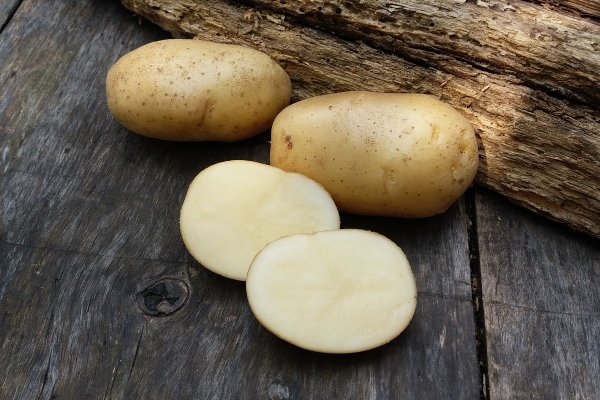

The height of Nevsky potato bushes is 50-60 centimeters. Leaves cover the powerful stem magnificently. They are wide, oblong, have a bright green color, the edges of the leaf are wavy.
Flowering is short, the buds are white, have bright orange pistils, form racemose inflorescences.
Roots
Ripe potatoes are light beige, oblong oval in shape with a delicate thin smooth skin. The pulp is creamy. The eyes are noticeable, pink in color. The weight of the tubers is 50-130 grams, the starch index is 10-13%.
Description
Today, Nevsky is the most common potato variety in the Russian Federation. It accounts for 26% of all potatoes grown in Russia.
According to the degree of maturity, the variety is classified as mid-season. The crop can be harvested 70-90 days after planting.
The potato tubers themselves are round, oblong.The average weight of a mature potato is 180-200 grams. The peel is smooth with a yellowish tinge. The eyes, which are pink in color, stand out perfectly against the entire background. There is little starch in the fruit, no more than 15%. The pulp is pure white. After cutting the root crop, it retains its freshness for a long time and does not darken.
The bushes are low. There are many sheets. They tend to regenerate quickly. Potatoes "Nevsky" without problems tolerate drought and temporary waterlogging of the soil. It also has good immunity to various diseases.
| Variety name | Nevsky |
| general characteristics | popular mid-early table potatoes with high yields |
| Ripening period | 70-85 days |
| Starch content | 10-12% |
| Mass of marketable tubers | 90-130 gr |
| The number of tubers in the bush | 9-15 gr |
| Yield | 400-600 c / ha |
| Consumer qualities | does not boil, the pulp does not darken |
| Keeping quality | good, but the tubers germinate early |
| Peel color | yellow |
| Pulp color | cream |
| Preferred growing regions | any |
| Disease resistance | moderately resistant to common scab and late blight |
| Growing features | cannot be planted in cold ground |
| Originator | CJSC "Vsevolozhskaya breeding station" (Russia) |
Medium early table variety, the period from the moment of emergence to the state of technical ripeness of tubers is 70-80 days.
The average yield of the variety is 400-450 c / ha, under especially favorable conditions it can reach 600 c / ha. The taste of the tubers is good. The starch content is between 12% and 14%.
"Nevsky" can be grown in different climatic conditions - it easily tolerates dry periods and is not subject to rotting with excess moisture.
The tubers are resistant to mechanical damage, which makes it possible to harvest using potato harvesters. The product yield is 90-95%. The variety is stored well, but the tubers begin to germinate quite early. To prevent this from happening, you need to know about the timing, temperature and problems that arise when storing potatoes. We also suggest that you familiarize yourself with the materials on storage in winter, on the balcony, in boxes, in the refrigerator, in a purified form.
Potato bushes are lush, medium height, semi-erect, intermediate type. The stems are well leafy, the leaves are of medium size, light green in color with slight waviness at the edges. Inflorescences are compact, consisting of many small white flowers. The flowering of the bushes is very abundant, but short-lived.
The tubers are oval, aligned. The peel is light beige, smooth or reticulate. The eyes are rather small, pinkish or purple in color. The number of tubers per bush is 15-20 pieces. They are all roughly the same size. The average weight of marketable fruits ranges from 90 to 130 grams.
The pulp is firm, not watery. The color of the middle of the tubers is white, the potatoes do not darken when cut and cooked.
The digestibility of potatoes is poor; in terms of culinary properties, it belongs to types B and C.
Potatoes "Nevsky" are practically not suitable for mashed potatoes and frying. The main purpose of the variety is to use it in soups and salads.
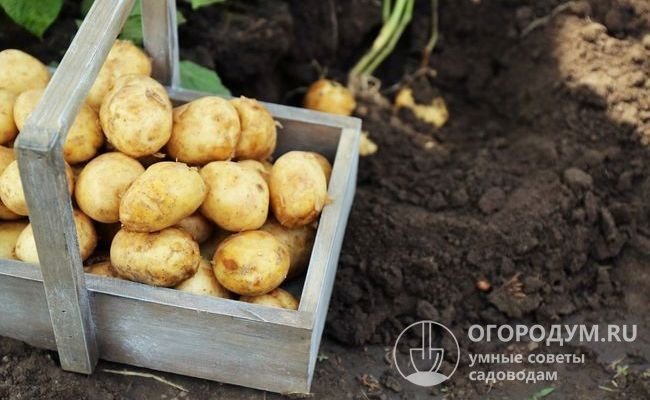

Bred by the breeders of the Russian Institute of Agriculture in the 70s, the Nevsky potato after 6 years already in 1982 gained popularity among gardeners and received from them its second name "blue eyes". This table potato variety is considered to be medium late. The technical ripening period is 2.5 - 3 months, young tubers can be eaten in the second half of July.
Sineglazka, according to agricultural technicians, is one of the high-yielding varieties. On average, 10-15 tubers with a total weight of 1 kg are removed from one bush, respectively, about half a ton of potatoes ripens on one hundred square meters of land.


What does the Nevsky potato look like?
The bushes are characterized by an average height not exceeding 0.6 m, the presence of many semi-spreading, erect stems. Each stem is strewn with small, densely planted glossy leaves of light green color.
Glossy foliage protects the soil from drying out by reflecting the sun's rays.
During the period of rapid flowering, the bushes are covered with many fluffy white inflorescences with a core shade of egg yolk.
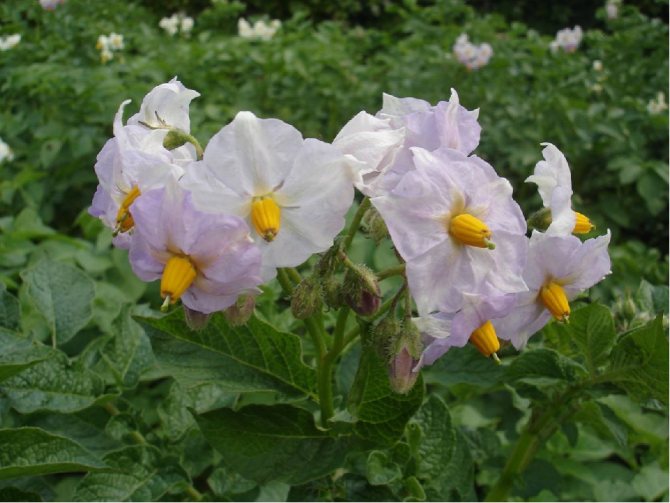

Nevsky potato flowers
Nevsky potato tubers are large enough, oval in shape, can reach 120 - 130 grams. The tuber rind is characterized by thinness and softness, has a light yellowish tint with the presence of small, pinkish, slightly depressed eyes. Thanks to these characteristics, potatoes are easy to peel and wash.
The pulp of a creamy shade has a homogeneous structure, without voids, after cutting it does not darken for a long time, since it contains a small amount of starch (about 10-12%), which makes this variety a dietary one.
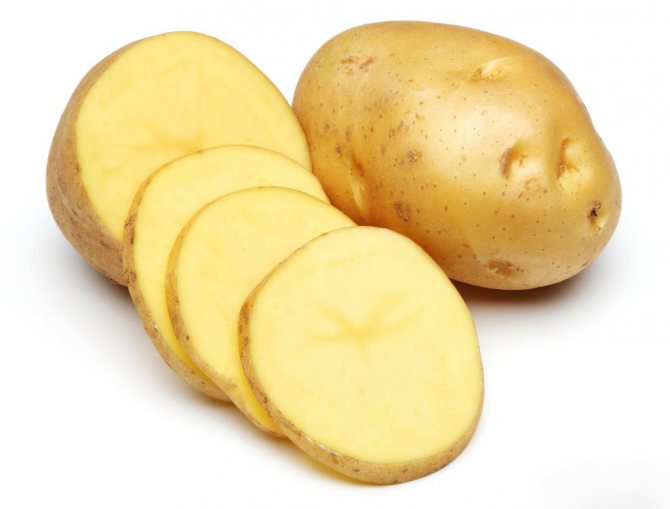

Tubers in the context of potato varieties Nevsky
According to the gardeners' reviews, the taste qualities of the Neva potatoes meet all the necessary requirements, the dishes prepared with their content are tasty and high-quality. But due to the low starch content, mashed potatoes or potatoes of the required consistency will not work.
The culture is stored for a long time - the percentage of tubers spoiled during storage ranges from 5-7%. A significant disadvantage of the variety is the earlier germination period compared to other varieties, even at low storage temperatures.
Table variety, medium-early ripening period: the period from germination to technical ripeness is 75-90 days. Differs in active development at the initial stages of the growing season - rapid growth of tops and early amicable tuberization.
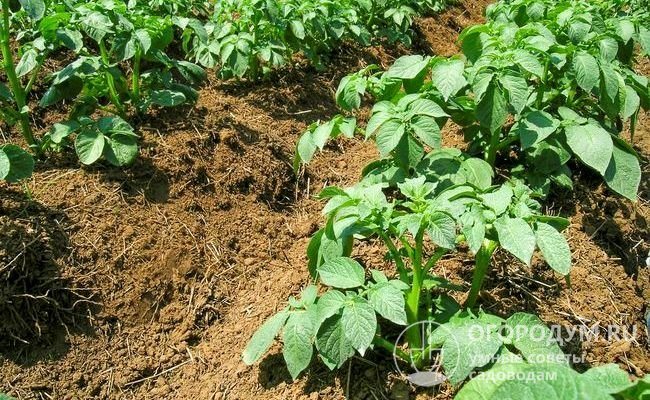

The aboveground part of the bushes is rather low, but strongly branched with a large number of stems and foliage
Plants of medium height, with a strong root system. Stems in the bush are erect or semi-spreading, densely leafy. The leaves are small, wide, light green in color, with a glossy surface and slight waviness at the edges. The flowering period is short but intense. The inflorescences are lush, consisting of flowers with white corollas.
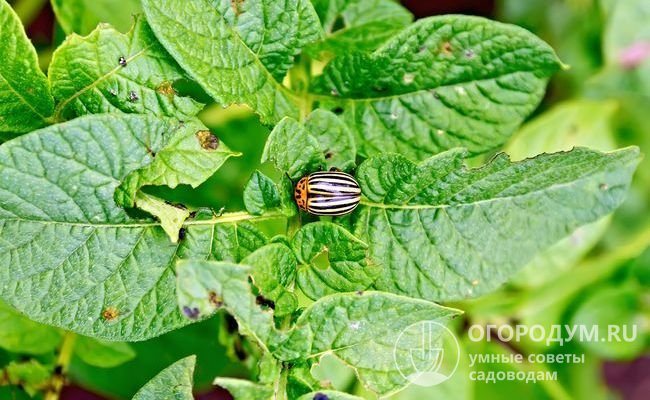

Many gardeners note the ability of "Nevsky" to quickly regenerate foliage after damage by larvae of the Colorado potato beetle
The abundance of leaves and their glossy surface, which reflects the sun's rays well, prevent the rapid evaporation of moisture from the root areas of the soil, which makes the bushes more resistant to drought.
Commercial quality tubers have an average size (weight 90-130 g), rounded or rounded-oval.


The peel of the tubers is light beige with small superficial white or pink eyes
| Nutrients and useful substances | Content |
| Starch | 10-14,8% |
| Vitamin C | 32-41 mg% |
The taste is good, it is best manifested in salads and soups, since the pulp keeps its shape well and does not color. According to reviews, potatoes "Nevsky" are not very suitable for frying and making mashed potatoes, which are tastier from more starchy varieties.


"Nevsky" is considered one of the best varieties for salads and soups
The tubers are quite resistant to mechanical damage during harvesting and transportation, they have high performance:
- marketability - 90-95%;
- keeping quality - 89-96%.
This variety is suitable for long-term storage. The dormant period of tubers is of medium duration, under proper conditions they are well preserved until spring, and then active and friendly sprouting of the eyes begins. "Nevsky" is not very susceptible to rotting and deterioration during storage, but it does not react well to the breaking off of sprouts.
Yield
The yield of this variety is fixed at the standard level and averages 380-500 c / ha.


About 8-12 tubers are formed in the nest, which provides a yield of up to 1.5 kg per bush
"Nevsky" is distinguished by stable productivity even in the most lean years and has great potential, since under favorable conditions and compliance with agrotechnical requirements, it is capable of producing up to 550-600 c / ha. The variety demonstrates endurance during periods of drought and excessive moisture in well-heated soil, gratefully responds to timely treatments against diseases and pests, fertilizing with mineral or organic (rotted compost, manure or bird droppings, wood ash, etc.) fertilizers when planting.
Sustainability
| Diseases | Degree of stability |
| Potato cancer (D1) | High |
| Viruses Y, A, X | High |
| Wet rot | High |
| Blackleg | High |
| Late blight of tops and tubers | Average |
| Rhizoctonia | Average |
| Common scab | Average |
Despite the presence of resistance, the variety is susceptible to the golden potato nematode (Ro1), it is recommended to treat plants with fungicides against late blight and insecticides against pests.
We have already mentioned some of them earlier: when cultivating, one should take into account the responsiveness of the variety to feeding and protective treatments, the need for timely digging of the crop.
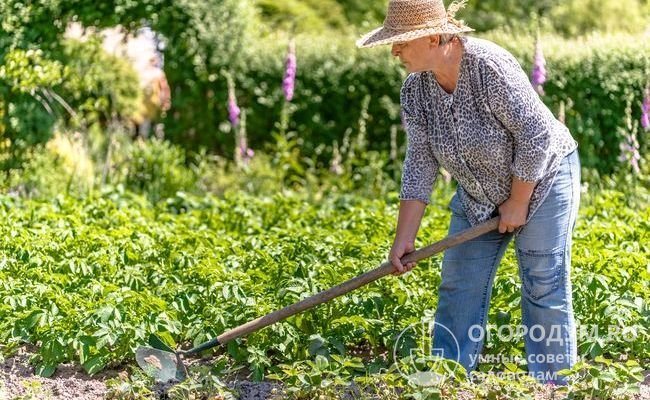

"Nevsky" is an unpretentious variety and can do without special care, but weeding of weeds, loosening of the soil and hilling increase its productivity
Characteristics and features of the variety
Potato variety Nevsky can be described through the following properties:
- aging time 75-100 days;
- drought-resistant;
- thermophilic;
- not afraid of waterlogged soil;
- good productivity;
- keeping quality index - 95%;
- marketable appearance;
- transportable;
- the taste is highly appreciated by the consumer.
It has good immunity to such diseases:
- potato cancer;
- scab;
- fusarium;
- verticillosis;
- late blight;
- blackleg;
- alternaria.
Potatoes Nevsky have a weak resistance to different types of mosaics, macrosporia, root rot. But the nematode is especially dangerous.
The Colorado potato beetle does not like Nevsky potatoes, and if there are other nightshades on the site, or next to it, he will prefer them.
Pros and cons of the variety
The many advantages of Nevsky include:
- High yields;
- Unpretentiousness;
- Rapid maturation;
- Excellent presentation;
- The ability to grow on any type of soil;
- Universal application;
- Disease resistance.
The ability to maintain shape during heat treatment allows the use of potatoes for preparing salads, first and second courses.
Of the shortcomings only susceptibility to nematodes is called.
Productivity and taste
One bush of the Nevsky variety gives from 8 to 15 tubers, which means in a weight equivalent of 1.5-2 kg. One hectare can be harvested from 380 to 500 kilograms of root crops. The most common indicator is 450 kilograms. The maximum harvest was 6 centners per hectare.
Most potato lovers highly appreciated the taste characteristics of the Nevsky variety. It is suitable for boiling, baking and frying, as well as for preparing salads and soups. But due to their low starch content, potatoes are not suitable for mashed potatoes at home or on an industrial scale.
Best dish with this variety
The low starch content does not allow the roots of Nevsky to crumble in boiled form, which is a prerequisite for the preparation of some dishes.
Swiss style potatoes
Ingredients:
- Nevsky potatoes - 1 kilogram;
- Butter - 1 tablespoon;
- Olive oil - 1 tablespoon;
- Tomato paste - 2 tablespoons;
- Cauliflower - 600 grams;
- Camembert cheese - 400 grams;
- Pepper and salt to taste.
How to cook:
- Boil washed tubers in a peel, cool, peel.
- Heat butter and olive oil in a deep frying pan, add potatoes, add salt and pepper.
- Fry over low heat until golden brown, covered with a lid.
- Flip over and fry the other side.
- Grease the potatoes on top with tomato paste, cover again, simmer for about 5 minutes, turn over.
- Boil the cauliflower until half cooked, after dividing it into inflorescences, add to the potatoes, mix.
- Cut the cheese into slices, spread on top of the vegetables.
- Heat covered until the cheese melts.
Can be served on the table.
Advantages and disadvantages of the variety
Like any other variety, Nevsky has its own strengths and weaknesses. Thanks to breeders, there are much more of the former:
- easily tolerates both drought and strong humidity;
- has a high immunity to the most common potato diseases;
- tolerates transportation well;
- has a pleasant appearance;
- has excellent taste;
- long shelf life;
- it is difficult for him to cause mechanical damage;
- adapted to the climatic characteristics of different regions.
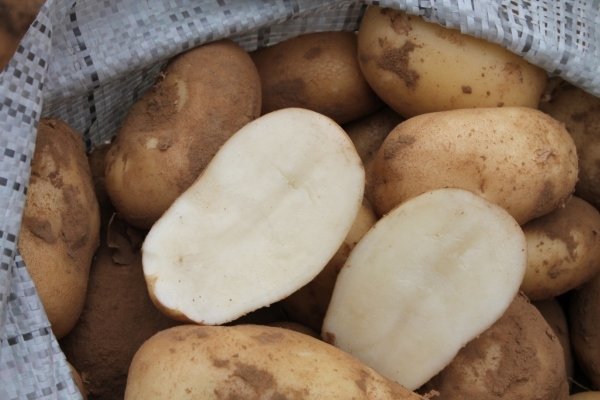

But the potato Nevsky also has negative sides:
- unsuitable for making mashed potatoes;
- nematode worms are dangerous to him;
- lush tops interfere with weeding.
To simplify the care of potato bushes, do not plant too close.
Storage
The right time for harvesting is signaled by the tops laid on the ground with dried foliage. Usually this phenomenon is typical during the end of summer.
After digging up the Nevsky potatoes, they are carefully dried in a well-ventilated warm place, sorted and stored. As such, the Nevsky potato variety does not have any preferences for storage, it is perfectly stored both in the basement and in the cellar.
The only important condition is the temperature regime not exceeding 5 ° С.


Storage of dried and resorted Neva potatoes
To summarize, we suggest that you familiarize yourself with a number of advantages of the Nevsky potato variety, and when planting next spring, make the right choice:
- a fairly high yield;
- resistance to various diseases and pests;
- unpretentiousness to climatic conditions;
- resistance to prolonged droughts;
- long shelf life;
- low starch content, relevant for those who follow the figure and are sick with diabetes.
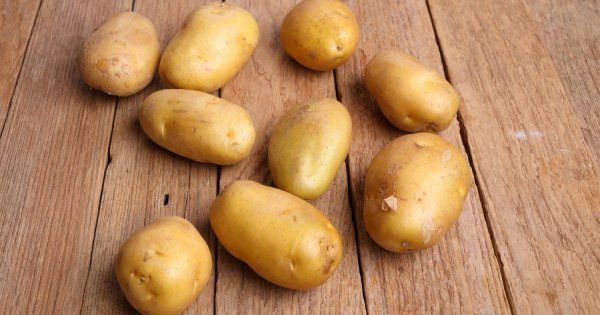

The Nevsky variety is not in vain popular among domestic gardeners - this potato is easy to grow, store, cook. This type of potato gives a stable harvest practically throughout the entire territory of Russia. Agricultural technology is not difficult, even novice vegetable lovers can cope with the cultivation.
Features of planting and growing potatoes Nevsky
This variety is unpretentious, but before planting, you need to find the right place and time, as well as prepare the seed material.
Optimal timing and choice of location
One of the main characteristic features of the Nevsky potato is its thermophilicity. Planting is allowed only when the soil has already warmed up. This condition is especially true for regions with frequent spring rains. Nevsky potatoes are resistant to moisture if the ground is already warm. Otherwise, it will deteriorate. When choosing a planting time, you should focus on the middle of spring, when there are no night frosts.
There are no special requirements for the soil, but this variety grows best in sandy loam and loamy soils. It is important that the landing site is not shaded. You cannot plant potatoes in the ground on which other nightshades, sorghum, sunflowers previously grew. Best of all, if last season in the selected area grew:
Site preparation for planting
In autumn, the earth is dug up, after which mineral fertilizers or cow dung with compost are applied. In the spring, a few days before planting, the soil needs to be rid of weeds, dig up and apply phosphate fertilizers.
Tuber preparation
In the case of Nevsky potatoes, it is very important for the yield to select and prepare the tubers correctly. Selection rules are strict.
Nevsky can not be cut into pieces or peeped out and planted separately. Planting is carried out only with whole sprouted tubers. Scratched tender sprouts will not yield a harvest.
When selecting, you should pay attention to the condition of the potato. The slightest sign of rot or mechanical damage makes the tuber unusable. Their weight should not exceed 80 grams and be less than 60 grams.
Before germination, root crops must be treated with a solution of potassium permanganate for disinfection. The tubers should either be washed or kept in it for 3-4 minutes.
Then they are laid out in one layer in a warm dry room for 2-3 weeks. Planting is carried out when the shoots are just emerging, and it is still difficult to damage them. Their height should not exceed 3 centimeters.
If the potatoes have sprouted and the weather is still cold, then place the planting material in a cool place. This will stop growth and harden the tubers.
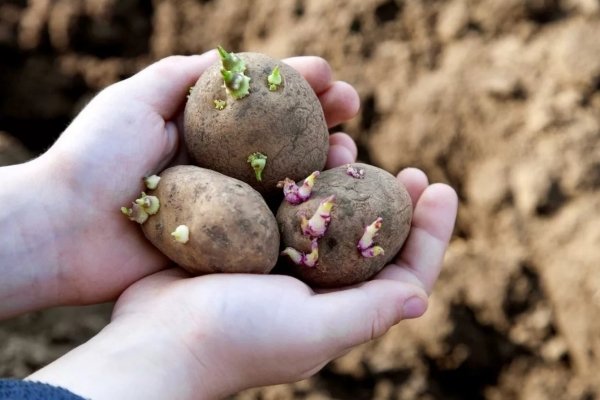

Landing in the ground, scheme and depth of planting
Landing is carried out in warm soil. If the bad weather in May lasts longer, then it is better to plant the potatoes earlier, otherwise they will not ripen until autumn.
We recommend reading: How to independently convert the steering wheel to the metering unit on MTZ. The device and the principle of operation of the device. Tips for correct installation. How to adjust the structure. Mechanism connection diagram. How to do it yourself.
Planting depth is 20 centimeters. The distance between the holes should be at least 50 centimeters; sometimes 30 centimeters are allowed. Between the rows - more than half a meter.
Sprouted tubers are placed and buried very carefully to avoid possible damage. After that, in the presence of dry soil, the first watering is performed.
Fertilization
Top dressing of potatoes of the Nevsky variety is carried out once at planting. In the future, the plant does not need it. Before placing the seed, fertilizer is poured onto the bottom of the dug hole. It can be:
- cow dung;
- wood ash;
- eggshell;
- bird droppings.
Read also: How to feed potatoes after planting
If the soil is noticeably depleted, then top dressing is allowed during the growth of the potato:
- After the appearance of the first stems, pour the urea solution under the root (half a liter per 1 bush).
- Before flowering - a solution of wood ash and superphosphate, in a ratio of 10: 1.
- During flowering - a weak solution of superphosphate.
In the absence of rain, watering of the Nevsky variety is carried out 2-3 times a week. It is best to use a spray bottle to provide a drip effect. It is necessary to water in the morning or evening, when there is no direct sunlight.
The first shoots will appear 15-20 days after planting. Before that, it is already necessary to weed and loosen the soil. During the growth of potatoes, these procedures are repeated at least 4 times.
When the sprouts reach a height of 15 centimeters, the first hilling is carried out. Carefully scoop up the soil so that it does not hit the leaves or sinuses. The second time the potatoes spud when the sprouts reach 30 centimeters. The procedure is performed in cloudy weather on moist soil.
Growing
Despite not being fastidious in terms of choosing a soil for planting, the best performance in growing a variety can be achieved by growing potatoes in a dry, sandy, sunny place rich in organic matter.
The presence of a powerful root system requires a sufficient distance between the holes, taking into account the fact that one bush should be located on an area with a diameter of about 45 centimeters.
Cold soil negatively affects yield and disease resistance, therefore, potatoes are planted when the soil warms up to a temperature of at least 14 degrees above zero. To get an early harvest, you should germinate the tubers in advance to a sprout height of 2-3 centimeters. For this purpose, they are placed in a warm, bright room a month before the start of planting work.The sprouts must be handled with extreme caution, since damage to them disrupts the germination process.
Nevsky potatoes suitable for planting in several ways: in ridges, in trenches, under agrofibre or film, square-nested. At the same time, fertilizers are applied in the form of ash, bone meal, humus, rotted manure. Ash and other potash fertilizers provide a pleasant taste for the tubers.
Further, feeding with nutrients is carried out only when necessary. Planting is watered, weeded, relieved of pests and diseases.
Drought and rainstorms do not have a significant impact on the development of crops, but a prolonged drop in ambient temperature negatively affects the amount of the crop.
Heavy watering and heavy rain can expose tubers, which, when exposed to sunlight, turn green and become unusable. Mulching will help fix this problem.
Watering potato plantings is carried out in the absence of precipitation for a week, this variety does not accept waterlogging.
To protect tubers from various insect pests, it is usually sufficient to treat them with a long-acting preparation before planting. During the growing season, the soil is treated twice from the bear. Filling the holes with ash significantly reduces the risk of damage to the potato by wireworm and bear, improves taste.
With a lack of nutrients, the bushes begin to lag behind in growth. Fertilizers are applied during root irrigation or by spraying the tops with special preparations in the evening or morning in calm, windless weather.
After harvesting, the soil is prepared for the new season. The site should be freed from tops and weeds. Having dug up the ground, it is recommended to add lime in the amount of two glasses per square meter. It is not required to level the soil.
With the onset of the planting season, the soil is fertilized with a mixture of a glass of wood ash, 1 tablespoon of superphosphate and 1 teaspoon of potassium sulfate per square meter. Second option: a glass of ash and 2 tablespoons of nitrophoska.
Peat soil requires a bucket of compost and humus per meter squared, clay: buckets of peat or humus, sandy: buckets of peat or clay soil.
Protection against diseases and pests
Potatoes of the Nevsky variety are resistant to most diseases, but the nematode poses a particular risk. To avoid infection with nematode worms, you must:
- loosen and cultivate the soil;
- carry out a careful selection of seed;
- adhere to crop rotation;
- if infected bushes are found, immediately remove and burn them, and treat the rest with Phosphamide.
To prevent potatoes from falling ill with late blight, you need to adhere to the conditions for caring for the vegetable, and spray the bushes twice a month with a solution of copper sulfate.
To protect against mice and insect pests, holes are dug on the site, poison and ultrasonic repellers are laid out.
The Colorado potato beetle is harvested by hand. Insecticide preparations are used as a poison: Iskra, Regent, Antizhuk, Prestige, Corado, Confidor, Aktara.
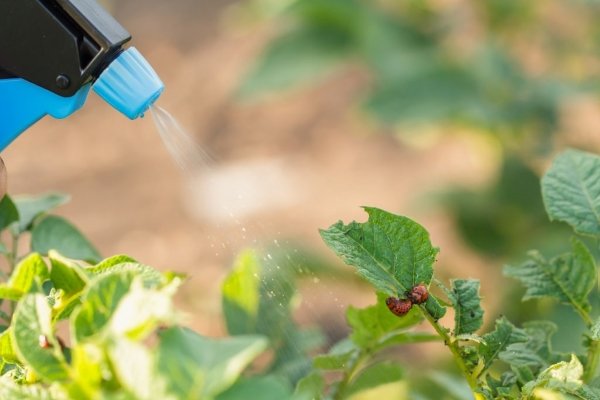

You need to get rid of the bear in advance. On the site chosen for potatoes, a dung heap is placed in the spring, in which the insect will lay its larvae. Shortly before planting the potatoes, the heap is burned. During the spring digging, large eggshells can be added to the soil - the insect will get hurt and leave the site. Medvetox and Bazudin are used to combat the bear. The latter is also effective against the wireworm - a worm that damages tubers.
Harvesting and storage
Young potatoes of the Nevsky variety are harvested in mid-July. The root crop is carefully removed by hand so as not to damage the entire root system. Full ripening occurs at the end of summer. You need to dig up the potatoes before the first cold weather. It is better to clean in dry weather.It is important to make sure that the shovel is no closer than 20 centimeters from the bush.
After removing from the ground, place the potatoes in a ventilated room to dry. When it dries out, the fruits are cleaned of dirt, the damaged tubers are selected, and the rest are folded into bags / boxes and sent to the cellar. These potatoes are best kept at +8 degrees Celsius.
Not every vegetable develops equally well in arid and rainy climates. This tolerance to climatic extremes makes the Nevsky variety universal for many public and private farms. It is appreciated for its simplicity, long shelf life, high immunity and excellent taste.
About the origin of the potato variety Nevsky
The variety was bred by the Leningrad Research Institute of Agriculture "Belogorka". An application for variety testing and registration in the State Register was filed in 1975. Nevsky was certified, in 1982 it was included in a single list as a selection achievement with a detailed description of varietal characteristics, zoned for all regions of the Russian Federation.
Amateur gardeners and farmers have been growing Nevsky for several decades. During this time, two stable and fair opinions have developed:
- Potatoes do not crumble during cooking, they can be cooked for hours. For this reason, many do not like Nevsky and refuse to grow it.
- With good agricultural technology, Nevsky is very fruitful, its tubers are smooth, well stored, do not turn black, are not hollow.
You can't argue about taste. Lovers of crumbly potatoes, really, it is better to choose a different variety. But if you need fruitful potatoes with beautiful tubers that will be used for making soups, winter salads, pancakes, vegetable stews, mashed potatoes, then Nevsky can be registered on your site for many years.
Description of the variety
Nevsky is a mid-season variety, 80–90 days pass from the emergence of seedlings to the maturation of tubers. Bushes grow sprawling, medium height, well leafy. In summer, they are covered with lush white flowers, but they form few berries.
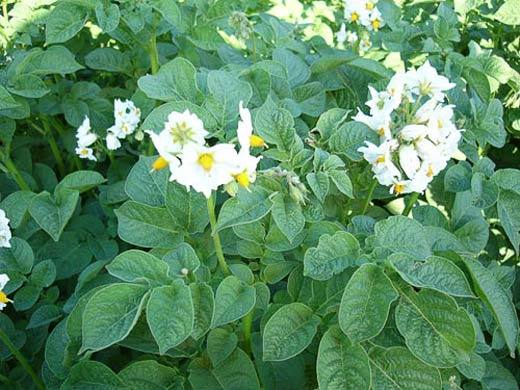

The bushes of Nevsky are lush, bloom with white corollas
In autumn, in each bush, you can find 10-15 potatoes weighing 90-130 g. Tubers are round or oval in shape. The pulp is white. The main feature by which you can recognize the Nevsky variety is the small pink eyes on the beige skin.
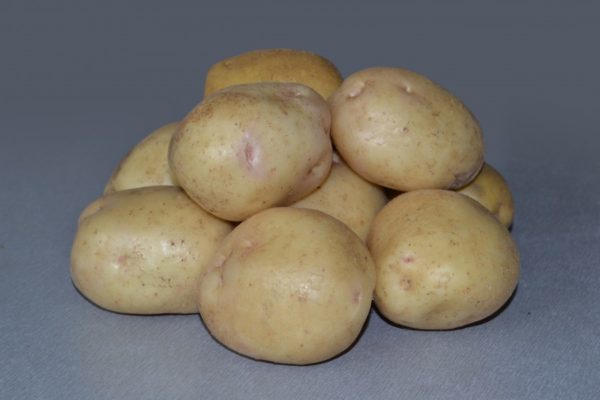

The variety Nevsky is easily recognizable by pink eyes on a beige peel.
- high yield - 380–500 c / ha;
- resistance to cancer and black scab;
- 90–95% of tubers have a presentation;
- potatoes are well stored, do not germinate for a long time.
The downside is moderate susceptibility to late blight. However, simple preventive measures will help to forget about this problem.
Video: Nevsky potatoes in comparison with other varieties
Reviews of gardeners
IMHO Nevskaya - soap and soap. Luck is much better, the only negative is not boiled over.
SSV
Guys, Nevskaya is a fodder crop. Bred and originally planted for livestock feed. Trends during breeding: unpretentiousness in cultivation, abundance of fruiting and a sufficient amount of carbohydrates. Nobody promised a taste, but it fulfills its functions: it bears abundantly even under unfavorable conditions.
Kety
I would recommend Nevskaya. At me, on the mountain, she did not go because of the wireworm and cancer, but for those who are at the pond, she gives a kilogram of five large tubers from a bush.
Read also: When to plant potatoes in 2020: auspicious days in May
DSP007
Nevsky was not happy, the harvest is not very good, he managed to get sick with late blight during a drought.
Shipkor
Many praise the Nevsky variety, it is argued that it is resistant to late blight. This is not entirely true. This variety is not resistant to the stem form of late blight. I also did not know what it was, until one year I encountered it. Suddenly and very quickly, the stems were startled and began to dry out quickly, the tops were green. The flow of nutrients has stopped, the peas have been collected.
Nemodny1966
I like the Nevsky potato variety.Its most attractive characteristic for many gardeners is its high resistance to a large number of diseases. The exception is the nematode. If your potatoes are sick, boldly destroy the infected bushes on the vine, otherwise the entire crop may die. A good prevention of nematodes is to fertilize the soil under the bushes with organic matter. Variety Nevsky - medium-early. You can start harvesting in mid-July to taste the young potatoes. In general, be guided by the tops. The harvest from Nevsky is high. Plants are unpretentious, but they like sandy soil and light loam. It is stored perfectly, does not germinate. Suitable for cooking and salads.
vetrov53
Potato variety "Nevsky" is my favorite. I prefer to plant it in my garden. Potatoes of this variety are tasty, good-looking, high-yielding. Resistant to crayfish, blackleg, etc. Stored very well. Productivity - up to 50 tons per hectare.
bigsev
We plant Nevsky potatoes. This is my favorite variety. It is such an elongated oval shape with a pinkish skin. Well, very tasty, both for frying and for cooking.
gerbera
Potatoes Nevsky are very responsive to good care: watering, feeding, protection from pests and diseases. In one place, it can grow and give rich harvests for 20 years, but on condition that you include fast-growing green manures in the crop rotation. The variety exhibits excellent yields and tubers that are never hollow.
Growing features
Nevsky pleases with the harvest when performing standard techniques for any variety:
- Observe the crop rotation, do not grow in one place for years.
- Renew your seed tubers every 5-6 years by growing them from botanical seeds.
- Introduce organic matter into the ground in the form of humus or compost - 2 buckets per 1 m².
- Sprout the seed tubers under light before planting.
- Plant when the ground warms up to + 10 ° C.
- From diseases and pests, carry out preventive treatments: tubers - when planting and bushes - during the growing season twice during the period from germination to flowering.
- Huddle as the tops grow.
- Water. Watering is especially important during budding and flowering.
- Feed one week after germination, and then every 2 weeks until flowering with special fertilizers for potatoes or nettle infusion with the addition of ash (glass per bucket).
- Harvest on time, remove all plant residues (tops, small, rotten and damaged tubers) from the site.
Recommended reading: Induction melting furnace
Nevsky has no peculiarities of cultivation, even the planting scheme is standard - 30 cm in a row and 60–80 cm between rows, the planting depth is 8–10 cm. The variety is suitable for natural farming.
Read also: Optimum storage temperature for potatoes
Video: poor harvest of Nevsky
Correct fit
When landing, you must follow certain rules:
- For planting, select medium tubers (from 60 to 80 grams). Before germination, the seed is placed for 2-3 minutes in a manganese solution for disinfection. Tubers are germinated for two to three weeks at a temperature of +15 to + 18 ºС. When the shoots have reached the required length (maximum 12 mm), the seed must be placed in a cool room to harden the tubers;
- Planting begins in early May. Before planting, the site is prepared and processed;
- The depth of the planting holes is 20 cm. Humus and wood ash are added to each hole.
REFERENCE: The later the seed is planted, the deeper the planting holes are made.
- The distance between the planting holes should be from 40 to 50 cm, the row spacing should be at least 60-70 cm.
How to collect 30-40 Nevsky buckets from one hundred square meters (personal experience)


In the scales are tubers from one Nevsky bush in my garden
I am the proud owner of this variety.It appeared 20 years ago, I liked the smooth tubers, the skin is always smooth, without scab sores, as is often the case with other varieties. In the first years, decent harvests were collected, and Nevsky was cultivated permanently on the same piece of land. The seeds were not renewed. Gradually, the yield began to decline. The tops dried out ahead of time, and more peas were found in the ground than commercial tubers. The harvest from two hundred square meters of 20 buckets has already become a record. At this time, I could complain on the forums that Nevsky is bad, sick, growing small, but I went the other way. I began to look for ways to revive the former indicators and learned to grow potatoes in such a way that Nevsky surpassed himself on my site. We collect 1.5-2.8 kg from a bush, 40 buckets from one hundred square meters. Moreover, the land is still the same and the seeds are also not renewed. Combined some of the techniques of natural farming and intensive agricultural technology. For seeds I take tubers from the most productive bushes. Before sending them for storage, I wash them in a solution of copper sulfate (1 tsp for 10 liters of water), dry them and plant them in partial shade. I store it in the cellar, in nets or baskets. Immediately after digging the potatoes, I level the ground with a rake and scatter green manure seeds over it. I really like mustard. She is a phytosanitary, oppresses pests, diseases and weeds. In the spring, a month before planting, I take out the seed material and spread it on the floor in the room. Once a week, I turn the tubers on their other side to the light and spray with clean water. In the garden, as soon as the ground thaws and dries up, I remove last year's siderates with a rake (I use them as mulch) and sow new ones. So much for the crop rotation. I don’t dig the earth! On the day of planting, I make holes right on the risen siderates, throw a handful of my compost into them and lay out the potatoes. I spray the tubers and wells with Tabu solution from the wireworm and the Colorado potato beetle, I cover it with earth.
I do not sow green manure in the potato field. Potato sprouts cannot penetrate through their powerful fibrous roots. I grow mustard, vetch, phacelia.
By the time potato shoots appear, the green manures are gaining a good mass. I tear them off with my hands and put them in the aisles. When the potato bushes grow up to 15–20 cm, I spray them with HOM or Skor, from the Colorado potato beetle - with Aktara or Karbafos. I repeat these treatments in 10-14 days. From the moment of emergence until the beginning of flowering, I feed it 2-3 times with BioHumus for potatoes, BioMaster or nettle infusion. If it's hot for a week, there is no rain, I water it by sprinkling from a hose with a nozzle. After flowering, the bushes in the rows close, from this time on, I don’t disturb the potatoes, I’m waiting for the tops to lodge. This year I refused not only from digging, but also from hilling. In the harvest they did not lose at all, on the contrary, at the family council they decided to allocate less land for potatoes, otherwise we gain so much from one hundred square meters that the four of us do not have time to eat until next autumn. Finally, I grew mini-tubers from botanical seeds collected from my own bushes. Next year I plan to renew the seed material. The fact that Nevsky is not boiled down is a plus for me. Once I tried to cook soup from crumbly potatoes, it all dissolved. And in mashed potatoes it doesn't matter what kind of potatoes you crush. Sometimes I want a whole crumbly one, for such a case I plant several rows of a different variety.


Harvesting Nevsky
Care
For proper care, you must perform the following activities:
- Until the shoots appear, the soil is carefully loosened and weeded two or three times so that weeds do not drown out young shoots, as well as to improve the supply of oxygen to the root system;
- With a long dry period, water the plants two to three times a week. Watering plantings in the morning or evening hours using a spray.
REFERENCE: In particular, watering is necessary during the flowering period.
- As soon as the tops begin to close for the first time, the aisles are deeply loosened. Tilling the soil to a depth of 8-10 cm completely frees the area from weeds and improves the drainage properties of the soil. During the season, another 2-4 loosening is carried out, depending on weather conditions and the amount of weeds;
- As soon as the plants reach 10-15 cm, the first hilling is carried out. The second time is spud when the tops are 25-30 cm.


